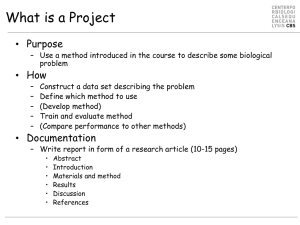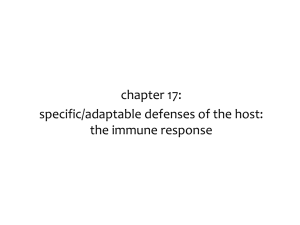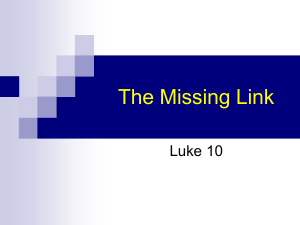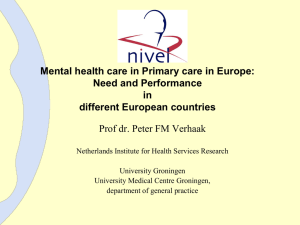Transplant Physiology of Sep 16 2009 by Dr. A. Gangji
advertisement
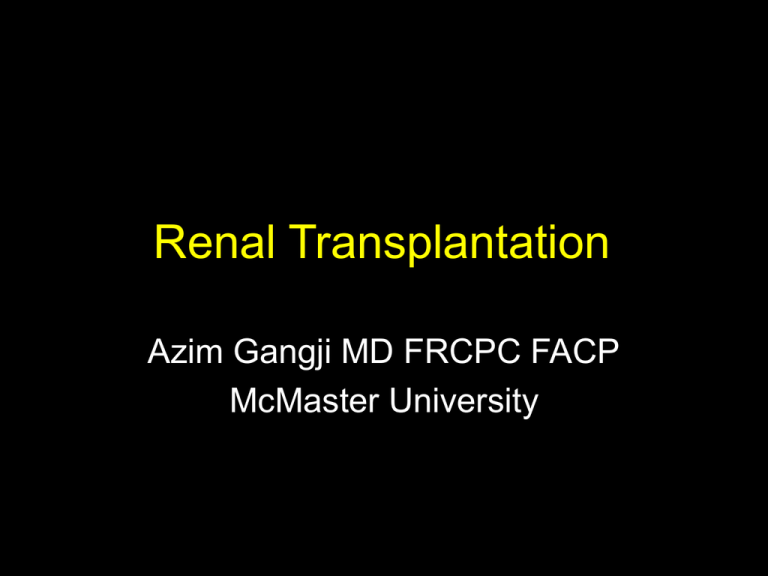
Renal Transplantation Azim Gangji MD FRCPC FACP McMaster University Objectives • • • • Overview of Immunology Cross match test Immunosuppressive Medications Rejection – Antibody Mediated Rejection – Acute Cellular Rejection • Causes of Allograft Failure • Surgical Complications • Longterm Medical Complications What is MHC and What is its Role • Human Leukocyte Antigen (HLA) system is synonymous with the human Major Histocompatibility Complex (MHC) • In humans, it’s called HLA due to expression of gene products on surface of WBC • These terms describe a group of genes on chromosome 6 that encode a variety of cell surface markers, antigen presenting molecules and other proteins involved in immune function • Inheritance ~ a haplotype from each parent What is MHC and What is its Role • HLA region is subdivided into 3 regions: – Class I • encodes “classical antigens” HLA A, B, C • Expressed on all nucleated cells • Class I alpha genes are coded by the MHC whereas the B microglobulin gene is coded on chromosome 15 (non MHC) – Class II • Encodes HLA- DR, DQ, DP • Has both alpha and beta genes both of which are coded by MHC genes • DR genes all share the same alpha chain but vary in the beta chain whereas DQ and DP can have polymorphic alpha and beta chains • In addition, the number of DR genes can vary among individuals. For example, 2 DR molecules are expressed on a single haplotype: both dimers use the same alpha chain but one uses a beta chain encoded by DRB1 and the other uses a beta chain encoded by a second DR locus called DRB3, DRB4, DRB5, etc. Alleles at this locus are usually expressed at much lower levels on the cell surface. – Class III • Contains genes for complement, TNF, Heat shock protein MHC Molecules 3D structure of MHC Class II Molecule Schematic of MHC • The structure of class I MHC and • class II MHC molecules. The schematic diagrams and models of the crystal structures of class I MHC and class II MHC molecules • Both types of MHC molecules contain peptide-binding clefts and invariant portions that bind CD8 (the 3 domain of class I) or CD4 (the 4 domain of class II). Comparison of MHC Class I vs II Comparison of MHC class I and class II molecules Class I MHC Class II MHC Structure MHC encoded chain, beta-2 microglobulin MHC encoded chain, MHC encoded beta-chain Antigen binding groove* Closed Open Peptide length 9 to 10 amino acids 12 to 28 amino acids Source of antigen Intracellular Extracellular Expression All nucleated cells B cells, macrophages, dendritic cells Antigen presented to: CD8+ T cells CD4+ T cells Direct and Indirect Allorecognition The Processing of Antigens and Presentation to T Cells T Cell Recognition of Alloantigen: Indirect Pathways • • • Intact donor MHC molecules are also known to be continuously shed into the circulation where they may then be endocytosed by the recipient's antigen-presenting cells. Within the acidic endosomal compartment, the MHC proteins are fragmented into their constituent peptides. They are then transferred into the endoplasmic reticulum, loaded into the antigen binding cleft of MHC class II of the recipient and finally expressed on the cell surface of recipients APCs. This mechanism has been referred to as the "indirect allorecognition.“ However, this is of course the normal route by which T cells normally encounter antigen ie in context of self MHC. T Cell Recognition of Alloantigen: Direct Pathways • • • T cell activation by the "direct" pathway occurs when T cells encounter intact donor MHC on the surface of donor antigen-presenting cells (APC). Since MHC molecules w/o a bound peptide are unstable & unrecognizable by T cells, endogenous proteins bound to the donor MHC may play a role. Direct allorecognition of intact surface MHC molecules has only been demonstrated in allogenic transplantation This pathway is thought to be of dominant importance during early acute rejection as engrafted organs contain a large number of passenger leukocytes. The Processing of Antigens and Presentation to T Cells C L A S S I C L A S S II T Cell Receptor and APC Interaction: Signal 1 • HLA peptide presentation by APC to T Cell • Triggering of the TCR by antigen initiates a signaling cascade started by the signaling complex made up of CD3 APC and T Cell Interaction: Role of Costimulation: Signal 2 Role of Costimulation: Signal 2 • • Naïve T cells require both signal 1 and Memory T cells do not require costimulation through CD28 to become activated. Costimulation through ICOS is sufficient for memory T cell activation. c, Absence of B7 or blocking of B7 with CTLA-4 Ig leads to anergy of the T cell. Allorecognition and Stimulation of T Cells and Effect B, T and NK Cells and Effect: Rejection • • • • • • • • • Fig 2. Classes of lymphocytes. Different classes of lymphocytes recognize distinct types of antigens and differentiate into effector cells whose function is to eliminate the antigens. B lymphocytes recognize soluble or cell surface antigens and differentiate into antibodysecreting cells. Helper T lymphocytes recognize antigens on the surfaces of APCs and secrete cytokines, which simulate different mechanisms of immunity and inflammation. Cytolytic T lymphocytes recognize antigens on infected cells and kill these cells. (Note that lymphocytes recognize peptides that are displayed by MHC molecules.) Natural killer cells recognize changes on the surface of infected cells and kill these cells. It should be emphasized that native T cells (CD4 or CD8) are activated by professional APCs. Effector CD8 T cells, not native T cells, can kill and infected cell expressing the specific peptideclass I complex. Immune Activation and Rejection Stimulus Activation Immune System Encounters the Transplant Hyperacute Rejection 0 0.5 1 Expansion T Cells T Lymphocytes Divide Are Activated Plasma And Make Cells Cytokines Make Antibody 2… 24 hours…. Rejection Effector T Cells Attack the Transplant Humoral Rejection 3-4 days… Memory Immune System Develops T and B cell memory 7 days... Acute Cellular Rejection T Cell Mediated Rejection • T cell receptor (TCR) of alloreactive cytotoxic lymphocytes (CTL) recognize allogeneic major histocompatibility complex (MHC) on target cells. CTL mobilize cytotoxic granules containing perforin and granzyme B (Gz B) toward the target cell releasing the cytotoxic molecules into the intercellular space. Perforin inserts into the target cell membrane and Gz B binds to its receptor and both are internalized to induce apoptosis. TCR stimulation increases expression of Fas ligand (FasL) on the CTL surface and binds the Fas receptor, triggering the apoptotic cascade. CTL can produce the cytotoxic cytokine tumor necrosis factor α (TNF-α), which binds the TNF-R on the target cell leading to apoptosis. CTL can also release interferon (IFN)-γ, which will activate the macrophage to release proinflammatory substances. NO, nitric oxide; ROS, reactive oxygen species. T Cell Mediated Rejection on Renal Biopsy • Tubulitis – Infiltration of tubular epithelium by T lymphocytes (arrows) that have crossed the basement membrane. • Endothelialitis – Invasion of the endothelium of a large artery by graftinfiltrating lymphocytes (arrow). Antibody and Complement Mediated Cytotoxicity ie AMR Antibody Mediated Rejection on Renal Transplant Biopsy • Evidence of peritubular capillary C4d staining c/w AMR Complement Dependent Cytotoxicity CDC Crossmatch Recipient’s serum + Donor lymphocytes (with defined HLA) + Complement, Incubate, add Eosin; remember here lymphocytes are just serving as cells Complement Dependent Crossmatch Pre-Transplant Therapy Antibody Suppression The Phases of Immunosuppression Late Acute Rejection Early Acute Rejection Maintenance Immunosuppression Acute Immune Desensitization Chronic Allograft Dysfunction Immune Accommodation Induction Therapy Acute Post-Transplant Immunosuppression Graft Failure Immunosuppressant Action Overview • Three events in T cell activation • Signal 1: Engagement of the T cell receptor with the antigen peptide in the context of self major histocompatibility complex (MHC) class II molecule leads to the activation of the calcineurin pathway and results in the induction of cytokine genes (e.g., interleukin [IL]-2). • Signal 2: The costimulatory signal, involves the engagement of CD28 with members of the B7 family. This synergizes with signal 1 to induce cytokine production. • Signal 3: Interaction between cytokine production and its corresponding receptor leads to induction of cell division, probably through the target of rapamycin pathway. This constitutes signal 3. Categories of Agents • Induction agents – Monoclonal or polyclonal antibodies – Administered intravenously in the perioperative period – Induce acute, powerful, short-lived immunosuppression • Desensitization agents – Pretransplant IVIg can desensitize patients’ immunity to HLA – Rituximab is gaining interest as a desensitization agent • Primary immunosuppressants – CNIs are the cornerstones of immunosuppressive therapy • Adjuvant agents – 1 or more medications prescribed in addition to a CNI Induction Agents • Non Depleting Antibodies – Basiliximab – Daclizumab • Depleting Antibodies – Alemtuzumab – Muromonab-CD3 – Equine polyclonal IgG antibody – Rabbit polyclonal IgG antibody Primary Immunosuppressants Calcineurin Inhibitors (CNIs) • • • Calcineurin inhibition prevents nuclear factor (NFAT) activation. In the absence of cyclosporine, calcium activates calcineurin by exposing its phosphatase site, which, in turn, activates NFAT. Cyclosporine forms a complex with cyclophilin (CP), which binds to calcineurin (CN) and sterically hinders the phosphatase site. Mechanism of Action: Tacrolimus • Calcium-CalmodulinCalcineurin form a complex to dephosphorylate NFAT • Tacrolimus binds to FK binding protein which binds to calcineurin and inhibits this process Is Tacrolimus Just a Clone of Cyclosporine? CNI Side Effects Event1 Hepatotoxicity Comments • Tacrolimus = CsA Cardiovascular • Less HTN and Hyperlipidemia with • Hypertension Tacrolimus • Hypercholesterolemia Post Transplant DM • Tacrolimus causes more post transplant Diabetes Mellitus Neurotoxicity • Tremor • Headache • Insomnia • Paresthesia • Seen more often with TAC and generally improve with dose reduction 1. Gaston RS. Am J Kidney Dis. 2001;38(suppl):S25-S35. 2. Johnson C, et al. Transplantation. 2000;69:834-841. 3. Margreiter R. Lancet. 2002;359:741-746. CNI Side Effects Event Comments Cosmetic • Gingival hypertrophy • Hirsutism • Alopecia • Use of corticosteroids may exaggerate development • Gingival hypertrophy and hirsutism are associated with CsA • Alopecia can occur with TAC Malignancy • Skin cancers • Cervical cancer • Lymphoproliferative disorders • Incidence appears to be a function of overall amount and duration of immunosuppression rather than any specific agent Gaston RS. Am J Kidney Dis. 2001;38(suppl):S25-S35. Metabolic Interactions That Increase CNI Levels • Calcium channel blockers – Verapamil – Diltiazem – Nicardipine • Antifungal agents – – – – – Ketoconazole Fluconazole Itraconazole Clotrimazole Metronidazole • Immunosuppressants – Sirolimus increases CsA levels • Antibiotics – Erythromycin – Clarithromycin – Azithromycin • Protease Inhibitors – – – – Saquinavir Indinavir Nelfinavir Ritonavir • Foods – Grapefruit – Grapefruit juice Metabolic Interactions That Decrease CNI Levels • Antituberculosis drugs – Rifampin – Rifabutin – Isoniazid • Anticonvulsants – Barbiturates – Phenytoin – Carbamazepine • Herbal preparations – St John’s wort Mechanism of action of mycophenolic acid (MPA) • Lymphocytes use the do novo pathway for generation of purines (guanine). • Mycophenolate mofetil (MMF) is converted in the liver by ester hydrolysis to mycophenolic acid which in turn non-competitively and reversibly inhibits IMPDH activity during DNA synthesis in the S phase of the cell cycle. • In the salvage pathway, guanine is converted to GMP by the enzyme hypoxanthine-guanine phosphoribosyltransferase MPA Adverse Reactions • • • • Bone marrow suppression n/v/d Oral and colonic ulcerations Colitis Azathioprine • Is an antimetabolite that is a purine analogue that is incorporated into DNA and halts synthesis • Inhibits proliferation of T and B cells and effect is mediated by AZA metabolites, 6-MP, 6-TU, 6-MMP, 6-TGN Azathioprine Adverse Effects • • • • Bone marrow suppression Hepatotoxicity Alopecia Drug Interactions: – Allopurinol Sirolimus/Everolimus • Sirolimus binds to FK binding protein but does NOT inhibit calcineurin. • Instead Sirolimus inhibits mTOR and blocks IL-2 mediated cell proliferation • mTOR activates protein that trigger cell cylcle G1 to S progression Sirolimus Adverse Effects • • • • • • • • • • • • Hypercholesterolemia Hypertriglyceridemia Edema Hypertension Rash Bone marrow suppression Interstitial pneumonitis Delayed wound healing Mouth ulcers Myalgia/weakness Drug fever Proteinuria Corticosteroids • Anti inflammatory and immunosuppressive effects • Suppress production of numerous cytokines (IL-1, TNF, IL-2, chemokines, prostaglandins, proteases, NFK-B) • Also affect chemotaxis (neutrophilia) Corticosteroids Side Effects – – – – – – – – – Acne Cushingoid facial appearance Hirsutism Mood disorders Hypertension Glucose intolerance Cataracts Osteoporosis Growth retardation in children Done by your Local Urologist I always recommend drinking at least 68 glasses of fluid for the procedure!” Transplant Surgery Transplant Surgery Post Surgical Complications • Vascular complications – Bleeding from vessels in the hilum – Anastamosis hemorrhage (more common with multiple arteries) – Renal artery thrombosis (due to hypotension in the OR, technical complications, antiphosholipid ab syndrome) – Renal vein thrombosis (usually 3-9 days post op and related to technical complications, antiphosholipid ab syndrome) Post Surgical Complications • Vascular complications – Transplant Renal Artery Stenosis • Atherosclerosis of recipient vessel • Clamp injury to donor or recipient vascular endothelium • Faulty suture technique (primarily seen with endto-end anastomosis • Angulation due to diproportionate length between graft artery and iliac artery • Kinking of the renal artery Post Surgical Complications • Lymphocele – Collection of lymph caused by leakage from several lymphatics that overlie the iliac vessels – Usually present weeks after transplantation – Can lead to ureteral obstruction, compression of iliac vein and swelling/DVT of leg, incontinence due to bladder compression, scrotal masses – Can be avoided by minimizing dissection of iliac vessels and ligating lymphatics – Sirolimus increased the incidence of lymphoceles from 18% to 38% therefore not used as an induction agent Post Surgical Complications • Urine Leaks – Occur within the first few days – Due to technical or as a result of ureteral slough due to disruption or ureteral blood supply. Blood supply to distal ureter is the most endangered during harvesting • Ureteral Obstruction – – – – Technical Blood clots Ureteral slough Ureteral fibrosis • Ischemia, rejection or polyoma virus BK – Extrinsic compression • Kinking or periureteral fibrosis from lymphoceles or graft rejection Post Surgical Complications • Wound – Infections – Healing becomes a problem in obese recipients • GI Complications – Bowel obstruction, colonic perforation, gastric ulcer Delayed Graft Function • Poor definition: – Need for dialysis in the 1st week post transplant • Etiology – Immune • Hyperacute rejection – Non immune • ATN, intravascular volume contraction • Technical: arterial, venous or ureteric occlusion, urine leak • Recurrent disease (HUS/TTP) Delayed Graft Function • Factors promoting ischemic injury in Deceased donor renal transplantation – Donor Factors (age, h/o HTN, DM, ARF) – Donor Management (brain-death stress, ionotropes, nephrotoxins, cardiac arrest) – Procurement surgery (Hypotension, traction on renal vessels, flushing solution) – Kidney storage (pump vs cold storage, prolonged time) – Recipient status (volume status, body habitus, pelvic atherosclerosis, poor cardiac output, hypotension in OR, preformed antibodies, prolonged warm ischemia time) Renal Transplant Program at McMaster University • All forms of transplantation – Standard Criteria – Donation after Cardiac Death – Extended Criteria (donors > 60yo, donors 5059yo with 2 additional RF (h/o HTN, death as a result of a stroke, elevated terminal serum Cr > 132umols/L) – Cross Match Positive Transplants – ABO incompatible Transplants Rejection and Treatment • Acute Cellular Rejection – Steroids, Thymoglobulin, CNI • Antibody Mediated Rejection – PLEX – IVIG – Rituximab – Bortezomib – Urgent splenectomy Rejection and Treatment • And of course prayer! Surgical resident ? Longterm Complications • Allograft Failure – On average 50% of DDRT allografts are functioning at the 10-12 year mark – On average 50% of living donor allografts are functioning at the 15-17 year mark – Etiology of Allograft Failure • Immune: Rejection, HLA mismatch, prior sensitization history, medication non compliance • Non Immune: donor factors (age, ECD, etc), CNI toxicity, HTN, Hyperlipidemia, Infection (CMV), Proteinuria, renal size mismatch, recurrent disease, BK Nephropathy Longterm Complications Longterm Complications • Renal Tx patients are at high risk of dying with a functioning allograft – 40% from CVD – 25% infection – 10% malignancy – 25% other Longterm Complications • CVD Risk Factors – 20% of renal transplant recipients will develop impaired fasting glucose post tx and 10% will develop T2DM – Prior ESRD pts – HTN – Hyperlipidemia – Cigarette smoking – Inflammation – Infections (CMV) Longterm Complications • Infections – CMV – BK – Hepatitis C – Influenza – Fungal Infection Timeline Post Transplant Fishman NEJM 2007 Malignancy • Skin Cancer: 3.5 fold increase • Post Transplant Lymphoproliferative disorder • GU cancers ~HPV related vulva, vagina, cervical cancers • Liver cancer (Hep B, C pts) • Cumulative incidence of malignant tumors over 30 years is 33% Summary • Overview of Immunology • Immunosuppressive Medications – Know pharmacology and adverse effects • Rejection – Antibody Mediated Rejection – Acute Cellular Rejection • Causes of Allograft Failure: differentiate immune vs non immune • Surgical Complications • Longterm Medical Complications Thank You For Your Attention • Causes of Elevated Resistive Index • Parenchymal – Acute Rejection – Acute Tubular Necrosis – Pyelonephritis • Vascular – Renal Vein Thrombosis – Hypotension • Urological – Ureteral Obstruction • Technical – Graft Compression
